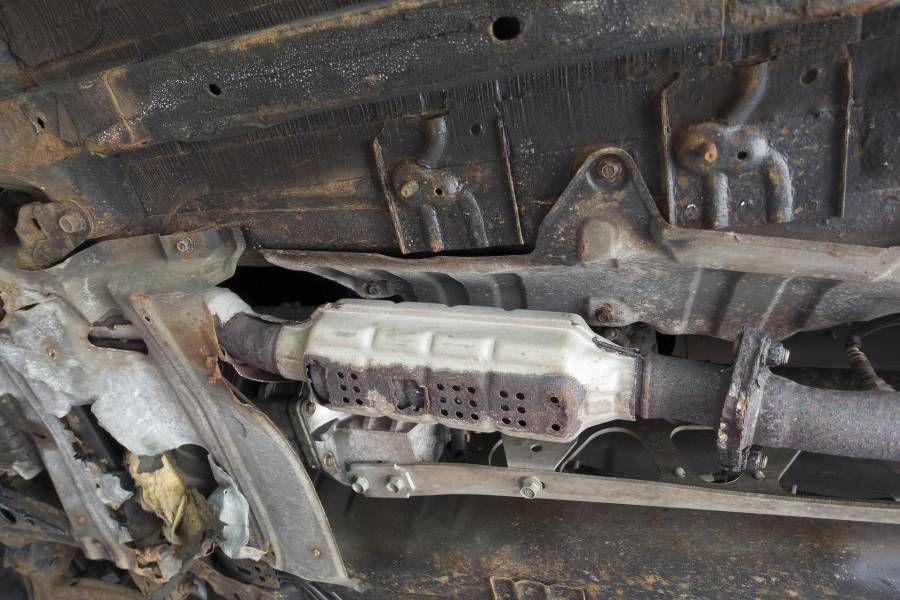Quick Navigation
Catalytic converters have been in vogue since the 1970s.
This component is attached to vehicles’ exhaust to ensure the gasses emitted are not harmful to humans and the environment.

However, due to their limitations, catalytic converters can fail and cause issues.
If the catalytic converter fails, the exhaust’s substance emitted into the atmosphere will become very harmful.
So, you may need to replace the faulty catalytic converter with a flex pipe.
In this guide, you will learn how to replace the catalytic converter with a flex pipe.
About Catalytic Converter
A catalytic converter is a vital part of the exhaust of a vehicle.
It is specially designed to convert the exhaust emissions generated by the engine into compounds that are not harmful to the environment.
Without a catalytic converter, emissions from the exhaust can harm our health.
Substances such as hydrocarbons, carbon monoxides, and nitrogen oxides are released into the air through the exhaust.
They are harmful by-products produced by the combustion engine in vehicles.
Since they are harmful, a catalytic converter is needed to transform the substances.
A catalytic converter is placed in a vehicle’s exhaust to convert highly harmful substances through chemical reactions.
It will make the substances less harmful and dangerous.
So this explains why a catalytic converter is present in vehicles’ exhaust.
The Purpose Of Replacing A Catalytic Converter
The purpose of replacing a catalytic converter is simple.
Once a catalytic converter becomes faulty, it ceases to be beneficial because harmful gasses will start coming out of the exhaust.
When a vehicle exhaust starts emitting harmful gasses, it becomes dangerous on the road. Also, the vehicle will not pass the emission test.
Hence, the need to find a replacement because imminent. That said, replacing a catalytic converter with a suitable pipe is crucial.
It is where flex pipe comes in. You can replace a faulty catalytic converter with a flex pipe.
A catalytic converter can be costly to maintain when it starts developing faults. So, to save cost, it is best to replace it with a flex pipe.
Now, the challenge is how to do it.
When replacing the catalytic converter with a flex pipe, you must ensure it is properly fixed.
In the next section, we will look at the key considerations of executing this process.
Considerations Of Replacing Catalytic Converter With Flex Pipe
When planning to replace a catalytic converter with a flex pipe, there are several considerations to keep in mind.
It includes considerations such as the significant benefits and downsides of the process.
It will make you understand if it is necessary to go ahead with the process or not.
So, here are key considerations to keep in mind:
- The Benefits of Replacing Catalytic Converter with Flex Pipe
- The Downsides of Replacing Catalytic Converter with Flex Pipe
Benefits Of Replacing Catalytic Converter With Flex Pipe
Despite their importance, you can replace catalytic converters with flex pipes.
So, we will look at what you stand to benefit if you decide to replace a catalytic converter with a flex pipe.
Here are some of the benefits of replacing a catalytic converter with flex pipe:
- It will save you the cost of replacing the catalytic converter permanently
- The use of flex pipes over catalytic converters improves gas mileage
- Removing a catalytic converter from the exhaust increases the engine power
- Gasses from vehicles are released faster and at a higher level with flex pipes
- Engine strain is highly minimized by replacing catalytic converters with flex pipes
- The engine operating temperature is considerably reduced with the use of flex pipe
- The sound coming out of the exhaust becomes healthier with the use of flex pipes
Downsides Of Replacing Catalytic Converter With Flex Pipe
As good as flex pipes sound, there are downsides attached to their use.
So, we will take a quick look at some disadvantages of replacing a catalytic converter with a flex pipe.
Here are some of the downsides of replacing catalytic converter with flex pipe:
- The use of flex pipe increases envisions concerns
- Flex pipes can easily trigger a fault code in the vehicle
- Driving a vehicle without a catalytic converter is illegal
- The vehicle will fail the MOT inspection test for safety
- The rate of poisonous gasses emission might increase
- The noise in the exhaust will likely increase while driving
- There might be a high fuel consumption rate in some vehicles
Tools Needed For Replacing Catalytic Converter With Flex Pipe
It is essential to use the right tools when replacing catalytic converter with flex pipe. It will ensure the flex pipe is fixed correctly.
When it is properly fixed, it will function very well.
So, here are special tools needed for replacing catalytic converter with flex pipe:
- Pipe Cutter
- Sawzall Saw
- Hydraulic Jack
- Sledge Hammer
- Ratchet Wrench
- Welding Machine
- Adjustable Wrench
Some of these tools require expertise. You might find it challenging to use them as an amateur.
Step-By-Step Guide On Replacing Catalytic Converter
Replacing a catalytic converter with a flex pipe requires proper execution. If the flex pipe is not well fixed, it will not function properly, affecting the car’s performance.
Here’s a step-by-step guide on replacing catalytic converter with flex pipe:
Step 1: Pack your vehicle on a level surface
[This will ensure that the vehicle is stable and balanced on the surface]
Step 2: Raise the vehicle with a hydraulic jack. Support the vehicle with jack stands
[Ensure you place jack stands under each corner of the vehicle’s frame]
Step 3: Wait for the exhaust to cool down before working on it. It will prevent burns
[The exhaust system might be scorching if the vehicle was just driven]
Step 4: Slide under the vehicle to spray penetrating fluid on the catalytic converter
[Leave the penetrating fluid to soak the mounting bolts of the catalytic converter]
Step 5: Remove the oxygen sensor from the catalytic converter
[You can use an oxygen sensor socket and a ratchet wrench to disconnect it]
Step 6: Loosen the mounting bolts on each end of the catalytic converter
[Use the adjustable wrench in a counterclockwise direction to loosen the bolts]
Step 7: Lower the catalytic converter carefully to the ground after removing the bolts
[This process is necessary to keep the catalytic converter for future installation]
Step 8: Cut the catalytic converter out if it was welded into the exhaust system
[This is an alternative method of disconnecting the catalytic converter]
Step 9: Place the flex pipe in the exhaust system through the void space
[Ensure you twist the pipe until the mounting holes line up with the exhaust pipe]
Step 10: Raise the vehicle with the hydraulic jack and remove the jack stands
[After, lower the hydraulic jack until the vehicle is stable on the ground]
Note: Always wear safety glasses and gloves when working on the exhaust system.
It is necessary to replace the catalytic converter in your vehicle once it starts to fail.
It will ensure that your vehicle runs smoothly and passes the required emission test.
Conclusion
Catalytic converters burn unburnt gasses from the exhaust to emit clean gasses. It’s a vital component of a vehicle emission control system.
But the need to change it can suffice.
The use of flex pipes as catalytic converters replacement is a temporary fix.
Despite being a vital car component in gas emission, catalytic converters add a great deal of back pressure to the vehicle’s engine.
For that reason, car owners consider replacing them with flex pipes.
Catalytic converters function like car mufflers because they muffle sound from the exhaust pipe. But you can replace them with flex pipes.
When you do that, there’ll be less pressure on your car’s engine, and your car will still function normally.
We believe this detailed guide has highlighted all you need to know about this process.

Patrick started his love affair with cars in his childhood. Over the years, he claims a sturdy hold on his driving skills, along with a thorough understanding of cars. We can expect some interesting, holistic, and pleasurable blogs with his flair for writing and his love for cars.
Being a car enthusiast, Patrick has experience comprising of two decades in which he has ridden some of the meanest and strongest machines in the automotive industry. His previous avatars include an automotive professional, photographer, and journalist, and you will certainly experience the roundness of experience in his piece on this site.
In his second decade of reviewing cars and analyzing tools, Patrick is all set to give you convincing, reliable, and the latest information regarding what’s happening in the automotive industry. Currently, he owns a BMW Z3 but cannot get his eyes off Aston Martin DB5. He is a car enthusiast; he loves cooking and listening to music, especially jazz. Here are some of the pieces written by our ace author.







